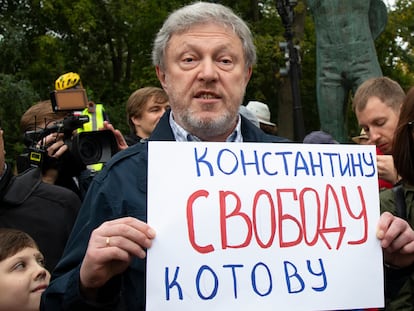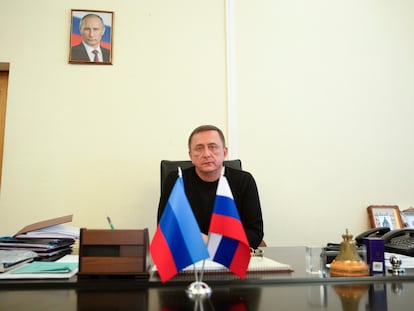‘We will feed your children with bones’: A cultural project documents Russian soldiers’ graffiti in Ukraine
The Wall Evidence initiative has collected over 400 graffiti and messages from invading troops that can be used to prove war crimes
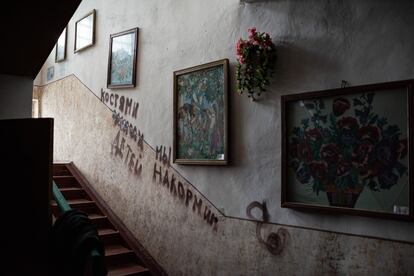

“We will feed your children with bones.” Russian troops painted this message in large, dark letters on the House of Culture in Novyi Bykiv, a village in northern Ukraine. The invader occupied the municipality between February and April 2022. About 450 kilometers (280 miles) to the east, in a village in Kharkov, another Russian soldier wrote the following reflection on a wall: “It is not a war crime if you enjoyed it.” In Russian-occupied regions of Ukraine, graffiti often serves as a means to intimidate the population or as a record of their presence in the war, but it can also be evidence of possible crimes. Mizhvukhamy, a Ukrainian cultural institution, has created the Wall Evidence project to document these written testimonies for their academic, historical and legal value.
Messages left by armies for posterity are as old as war itself. On Hadrian’s Wall, between what is now England and Scotland, soldiers from the 20th Roman legion Valeria Victrix inscribed their names while building the wall and its forts in the 3rd century A.D.; Italian fascists also left graffiti in Spain during the Spanish Civil War expressing their support for Francisco Franco and Benito Mussolini. Russian troops are no exception: the difference is that the massive use of cell phones now makes it possible to keep an exhaustive record of these macabre testimonies.
The Wall Evidence map includes about 400 messages, spread across provinces that were occupied by Russia and liberated by Kyiv between February and November 2022. The project is driven by images that citizens send in, pictures published in the media and posts on social media. Few of those images come from territories that are still controlled by Russia, because of the risk of Russian authorities identifying the person who sent the images, explains Anastasiia Oleksii, who manages the Wall Evidence initiative. One picture in Mariupol shows a post office with the word “morgue” painted on it, indicating that the invader used those premises to pile up civilian corpses during the 2022 occupation of the city. From the village of Basan, Zaporizhzhia, there are several messages written in chalk on school blackboards in which the occupying forces ask for forgiveness.
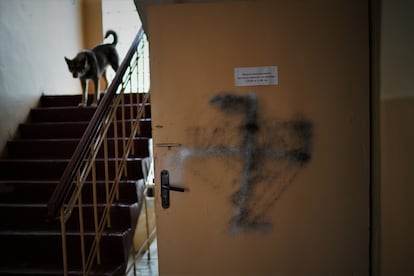
In about 10% of the messages that the Wall Evidence initiative has cataloged, the perpetrator apologizes for the harm they have caused. “In the Russian worldview the concepts of crime and repentance do not exist, although they know about the atrocities they commit, that’s why they sometimes ask for forgiveness, but they are never sincere,” writes Pavlo Haidai, the founder of Mizhvukhamy. Haidai cannot disguise his hatred and considers Russians “inhuman.” He adds that “we have learned that Russians live in a hostile animal environment in which it is necessary to mark their territory.”
Because of the way they are written, many messages of repentance also suggest mockery. For instance, in a school in Trostyanets, a village in northern Ukraine, Russian soldiers drew flags and smiley faces and wrote: “We don’t need this war either. We have been sent. Sorry. We’re following orders. Glory to Russia. We’ve made a bit of a mess of things. But the Americans will help you clean it up.” In Katyuzhanka, a township on the way to Hostomel, Bucha and Irpin, where the United Nations has documented multiple Russian war crimes, a soldier left a note at the home where he had resided: “Thank you very much for the comfort of your house. Sorry for the door and the garden. Thank you for the food. May God bless you. With love from Russia, peace to your home.”
Wall Evidence classifies the messages into nine categories: most are military administration signs, the famous letters V and Z, symbols of Russian military units; there are warnings that passing is prohibited on pain of being shot, and indications that a certain room is intended for interrogation; there are also nationalistic messages and threats to the Ukrainian population; some graffiti rants about the West, while other inscriptions commend their religious faith and, finally, other messages evoke Soviet World War II victories.
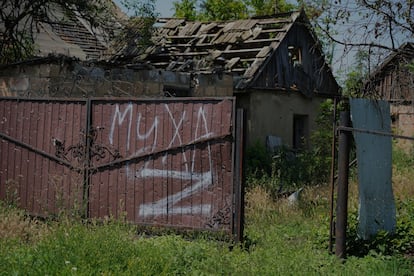
Anna Samchuk, a sociologist who works for the Wall Evidence team, explains that “graffiti traces the author’s state [of mind] at the moment of writing it, their projection of reality.” According to her study of the documentation, Samchuk discerns three common denominators: on the one hand, despite Russian propaganda claiming that Ukraine is a part of greater Russia, soldiers leave messages in which “they assume that they come from a foreign country”; on the other hand, according to Samchuk, soldiers “know subconsciously that they could be killed” and “they project this fear of death with a desire to leave something behind, their inscriptions.” Finally, the sociologist concludes that the threats and messages that make it clear that they want to dominate Ukraine are evidence of the invader’s culture. She says that is “because domination and subjugation are typical of Russian culture and its way of interacting socially.”
Soldiers rarely identify the regiments in which they serve, or even their names, but when they do, Ukrainian authorities trace it to determine which units occupied a place and the crimes they may have committed. According to Oleksii, they could identify one of the Russian soldiers involved in the massacre of civilians in Bucha this way. The Wall Evidence director points out that a signature with a nickname or initials can be used to identify someone from their social media.
In Kozacha Lopan, north of Kharkov, the Russian occupiers set up a torture and interrogation center in the cellar of the railroad station. Less than a mile from the station, someone wrote one of the Wagner mercenary group’s identifying slogans on a house: “We will rise from the ruins of the fallen cities and write your names in the book of the dead.” Oleksii provides another example that confirms the presence of Wagner mercenaries in an occupied village of Chernihiv, with a slogan: “Let those who doubt our peace drown in blood. Because our grace will be merciless.”
Sign up for our weekly newsletter to get more English-language news coverage from EL PAÍS USA Edition
Tu suscripción se está usando en otro dispositivo
¿Quieres añadir otro usuario a tu suscripción?
Si continúas leyendo en este dispositivo, no se podrá leer en el otro.
FlechaTu suscripción se está usando en otro dispositivo y solo puedes acceder a EL PAÍS desde un dispositivo a la vez.
Si quieres compartir tu cuenta, cambia tu suscripción a la modalidad Premium, así podrás añadir otro usuario. Cada uno accederá con su propia cuenta de email, lo que os permitirá personalizar vuestra experiencia en EL PAÍS.
¿Tienes una suscripción de empresa? Accede aquí para contratar más cuentas.
En el caso de no saber quién está usando tu cuenta, te recomendamos cambiar tu contraseña aquí.
Si decides continuar compartiendo tu cuenta, este mensaje se mostrará en tu dispositivo y en el de la otra persona que está usando tu cuenta de forma indefinida, afectando a tu experiencia de lectura. Puedes consultar aquí los términos y condiciones de la suscripción digital.
More information
Últimas noticias
Most viewed
- Sinaloa Cartel war is taking its toll on Los Chapitos
- Oona Chaplin: ‘I told James Cameron that I was living in a treehouse and starting a permaculture project with a friend’
- Reinhard Genzel, Nobel laureate in physics: ‘One-minute videos will never give you the truth’
- Why the price of coffee has skyrocketed: from Brazilian plantations to specialty coffee houses
- Silver prices are going crazy: This is what’s fueling the rally
